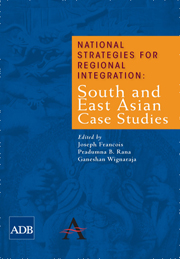8 - Thailand
from East Asian Perspectives
Published online by Cambridge University Press: 05 March 2012
Summary
Introduction
Policies of economic growth led by exports and foreign direct investment (FDI) have been the main driving forces behind Thailand' economic progress. Trade and FDI performance has increased considerably since the second half of the 1980s, even accounting for the sluggish period around the 1997/98 financial crisis. While economic ties with the Association of Southeast Asian Nations (ASEAN); the People' Republic of China (PRC); Hong Kong, China; Japan; the Republic of Korea; and Taipei,China have considerably strengthened, links with South Asia remain weak. There is much room for improvement, therefore, especially given Thailand' geographical position and potential to serve as a bridge between East and South Asia. Increasing FDIs from both the PRC and India could likewise be first steps toward deepening economic relationships between the two Asian subregions.
Thailand is actively taking part in a number of regional trade agreements, at both the multilateral and bilateral levels. In addition to the ASEAN Free Trade Area, Thailand has bilateral free trade agreements (FTAs) with Australia, India, and New Zealand, as well as a regional trading agreement under the China-ASEAN FTA. Thailand has also been unilaterally reducing its tariff barriers, as evidenced by a fall in average applied tariff rates. The Government also implements trade and investment promotion programs that include (i) the provision of financial facilities and bilateral financial arrangements; (ii) the establishment of overseas export promotion offices; and (iii) the launching of investment privileges such as export processing zones (EPZs), special economic zones (SEZs), and industrial estates.
- Type
- Chapter
- Information
- National Strategies for Regional IntegrationSouth and East Asian Case Studies, pp. 383 - 482Publisher: Anthem PressPrint publication year: 2009



